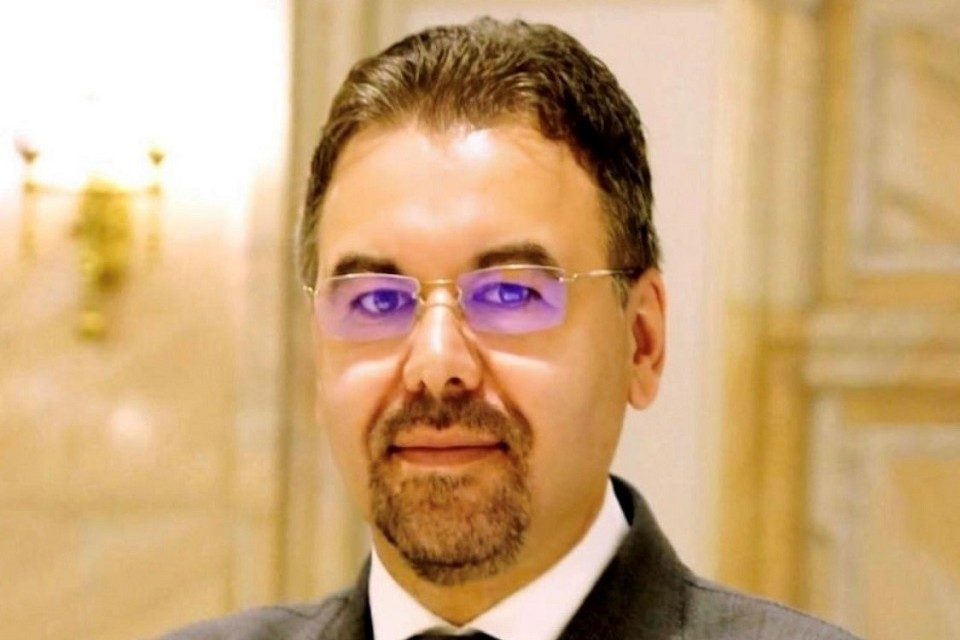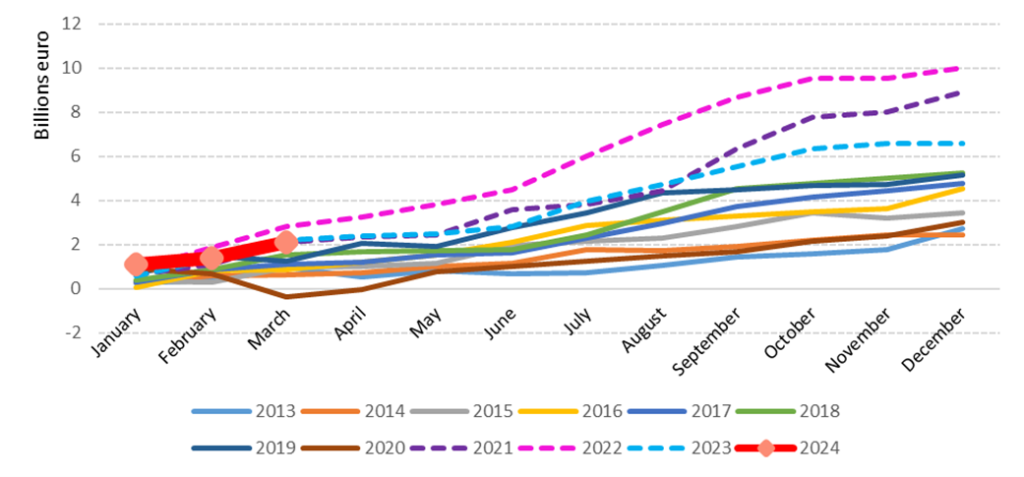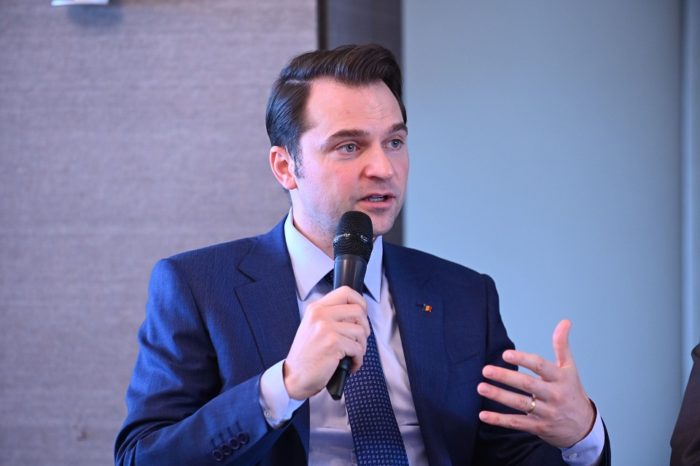Leonardo Badea (BNR): Premises for increasing foreign direct investment in Central and Eastern Europe. The case of Romania

Attracting foreign direct investment (FDI) is essential for the emerging countries of Central and Eastern Europe to achieve a rapid pace of economic development. In the medium and long term, these investments contribute to economic stability and the improvement of living standards. Thus, FDI generates employment opportunities and stimulates productivity growth through the transfer of technology, know-how, and managerial skills. They also diversify the industrial facilities of these countries, reducing dependence on imports in key areas and increasing the resilience of local economies to external shocks. In addition, the attracted capital fosters innovation and facilitates the access of local companies to international markets. Thus, increasing the attractiveness of countries for FDI becomes a strategic objective in the context of regional and global competition, including in the context of the recent, but apparently increasingly accentuated, phenomenon of “reshoring” (phenomenon determined by the geopolitical context of recent years and contrasting as a direction of action to the regional and global diversification of companies’ activities).
Romania, in particular, must capitalize on these opportunities, and the focus must not be placed only on infrastructure development (even if we need to recover as quickly as possible the large gap created over time to our disadvantage). Infrastructure has favorable chain effects for economic evolution, but it must go in parallel with programs that directly address the need to maintain the rate of growth of the productivity of FDI activities. At the same time, we must continue to act with a wide spectrum of measures to increase competitiveness on foreign markets: improving the legal framework, reducing bureaucracy in the interaction between the business environment and the public administration, a predictable and easy to apply fiscal conduct, maintaining a competitive environment, sanctioning firmly and without exception unfair practices to preserve equal conditions for all companies in specific fields of activity, a more balanced functioning of the labor market, supporting access to training programs adapted to the current needs of employers, supporting applied research in partnership with the business environment, further ensuring access to financing programs.
1. Investments in the emerging countries of Central and Eastern Europe continue to represent a good opportunity for investors who want to diversify their portfolios and take advantage of the region’s potential economic growth alert (eng. “catching-up”).
The statement is not exaggerated, even if a number of exogenous factors, especially of recent manifestation, influence the attractiveness of Europe as a destination for investors. The COVID-19 pandemic has caused significant disruptions in distribution chains and a strategic reorientation in this sense, even reaching the point of questioning the model based on globalization and agreeing to alternative development models that respond to the new requiremenst and economic challenges. The pandemic shock was soon doubled by the conflict in Ukraine, which induced a heightened sense of uncertainty, especially in the area of the countries bordering this outbreak. Energy costs, inflation, but also previous underlying issues related to the climate and demographic crisis add to the new big picture. The increases in interest rates applied by central banks, the slowdown in the pace of economic growth, but also the deterioration of economic relations with Russia have essentially outlined a new reality in Europe.
At the same time, however, the strengths cannot be neglected either, in a European Union that has demonstrated its core values. During the recent crises, the Union offered a strong example of solidarity and resilience, while keeping as its primary objective the transformation for the world of the future, a “green”, inclusive, and digitilized world. At the same time, it must be stated that EU countries have proven their resilience by exceeding expectations – inflation rates, although above multi-year targets, are on a relatively alert downward trend, and economic activity is estimated to gradually increase in 2024 supported by investments, but also by the return of consumption, according to the latest Report on economic forecasts of the European Commission.
In the general European context and despite the recent crises, the countries of Central and Eastern Europe remain anchored on a generally positive trajectory, with access to EU funds as the specific driver of growth. Given the forecasts of an economic growth higher than that of Western countries, they retain their attractiveness as destinations for investment. The EU membership, the positive economic evolution of recent years, significant progress in the area of digitalization, but also the concern for creating a legislative environment conducive to foreign investments have turned Central and Eastern European countries into extremely attractive destinations for investors.
2. Many countries in Central and Eastern Europe have seen significant development and attracted more and more foreign direct investment in recent years. Economic growth, a highly skilled workforce, and strategic location drove investor interest.

Beyond common features and advantages (EU membership, OECD member or candidate status, availability of European funds, European regulatory framework), each of the Central and Eastern European countries presents individual advantages and particularities that differentiate them in their approach to attracting FDI.
For example, the attractiveness of Poland as a destination for foreign investors is supported by the concern for the development of a legal framework conducive to investments, by the renowned efficiency in accessing and using European funds and, last but not least, by the pro-European orientation demonstrated in the elections at the end of the year 2023.
The confirmation of Poland as an offering destination for investors is also supported by the impressive ratings: A2 (Moody’s) and A- (Standard&Poor’s and Fitch), values that indicate 4 or even 5 steps above the “non-investment” level. Even though in 2023, Poland’s economy registered growth below the forecast, of only 0.2%, expectations for 2024 are of acceleration to 2.7% (the latest forecast of the European Commission).
The Polish Investment and Trade Agency (PAIH) has announced a record foreign direct investment in 2023 to be implemented through the agency, estimated at more than 7.4 billion euros, almost double the amount of 2022 (https://www.trade.gov.pl/en/news/a-record-breaking-2023-for-paih/).
At the same time, it is worth noting the strengthening of Poland’s position in the semiconductor sector, through the investment announced by Intel, with a crucial role in determining the technological advance and implicitly, in the transformation of our world due to technology, a transformation that we have already been witnessing for some time. The unprecedented development in the field of artificial intelligence, the Internet of Things (IoT) or 5G networks and the implications for all economic sectors are directly linked to the evolution of the semiconductor sector. Let’s remember that only a few years ago, we witnessed a decline in semiconductor production, aggravated by the onset of the COVID-19 pandemic superimposed on the already existing difficulties in responding to a growing demand (accentuated also by the phenomenon of “friend-shoring” induced by the recent tensions between the US and China), which has caused a series of negative effects in various industries, ranging from the unavailability of some products to the increase in prices.
Finally yet importantly, Poland is recognized for its highly dynamic IT sector, with over half a million well-trained specialists.
In turn, the Czech Republic is at the top of Central and Eastern European countries in terms of FDI inflows, reaching EUR 9.3 billion in 2022, up from 2021 (UNCTAD’s World Investment Report 2023).
Among the important foreign direct investment projects developed in the Czech Republic in recent years are those in the research and development sector of technology giants such as IBM and Honeywell, with the support of local government policies that provide incentives for high value-added projects, especially in fields such as IT, nanotechnology, and applied sciences. At the same time, the Czech Republic is an important hub for the automotive industry, with companies such as Škoda Auto (part of the Volkswagen Group) and Hyundai Motor Company continuing to invest heavily in modernizing and expanding local production capabilities. In the manufacturing industry, investors from Japan and South Korea have made significant investments in factories and production facilities, helping to increase the country’s industrial capacity.
CzechInvest, the government’s investment promotion agency operating under the Ministry of Industry and Trade, has actively promoted the attraction of foreign investment, particularly from technology companies. At the same time, CzechInvest offers assistance during the implementation of investment projects, consulting services for foreign investors entering the Czech market, support for suppliers, and assistance for the development of newly established companies that favor innovation.
Hungary reached a new record level of FDI in 2023, surpassing 13 billion euros, double the level of the previous year’s record of 6.5 billion euros, according to HIPA (Hungarian Investment Promotion Agency) (https://hipa.hu/news/previous-all-time-high-fdi-inflow-doubled-in-hungary/). As in previous years, Hungary has attracted a large volume of investment in the automotive industry, especially electric ones (https://www.intellinews.com/hungary-s-fdi-soars-to-over-13bn-in-2023-306525/), demonstrating concern for transformation and adaptation to the new demands of the economy and society. Thus, Hungary becomes an important player in this sector, with prospects of becoming the second largest producer of electric car batteries in the world. It is a remarkable performance with a major medium-term impact on the entire economy. It is also worth noting that Hungary has become the preferred investment destination in the area for some Asian countries (China, South Korea, or Japan), countries that provide almost 82% of the total flow of FDI (https://hipa.hu/news/previous-all-time-high-fdi-inflow-doubled-in-hungary/).
In Bulgaria, the net flow of foreign direct investment increased in 2023, reaching 3.37 billion euros, according to the central bank (https://seenews.com/news/bulgarias-net-fdi-inflow-rises-28-in-2023-848774#:~:text=The%20largest%20net%20FDI%20inflow,Ireland%20with%2022%20million%20euro).
Unlike the previously mentioned countries, Bulgaria remains attractive primarily for its low labor costs and low level of taxation. At the same time, however, concerns persist about the political situation, bureaucracy, and the lack of predictability caused by relatively frequent changes in the legal framework. The Covid-19 pandemic strongly impacted important sectors, such as tourism, services, and logistics, while the war in Ukraine caused the disruption of distribution chains and contributed to the increase in inflation.
In 2022, foreign direct investments in Romania reached a record level of over 10 billion euros, an increase of 12.3% compared to 2021 (NBR – Foreign direct investments in Romania in 2022). This advance was supported by a multitude of favorable factors, some of them being only of a conjunctural nature, while others reflected the relaxation of pandemic restrictions, but also the resilience of the Romanian investment climate, despite geopolitical tensions and the energy crisis. Investments were mainly concentrated in industry, trade, and financial and insurance services. In 2023, however, FDI decreased to around 6.6 billion euros. The level in 2023 is also lower than the one recorded in 2021, before Russia started the war against Ukraine, but it is still clearly higher than in the pre-pandemic years.
The data from the financial account of the balance of payments regarding the structure of the net flow of FDI (Figure 2) show that all three important categories of components had a contribution to the decrease from the year 2023. It is also observed that in 2023, foreign direct investments in the form of the contribution to the equity capital of Romanian FDI companies recorded the second consecutive year of decline and dropped to one of the lowest levels in the last 19 years. At the same time, however, the reinvested earnings remained at one of the highest levels in the mentioned period.

A positive element that can be observed in the figure above is the fact that, over the entire analyzed interval, the two elements of equity participations mentioned previously remain dominant in relation to the amount of debt instruments. Thus, in March 2024 (according to the latest available data on the FDI position according to the directional principle), equity participations recorded the highest share of the total FDI position in the last 10 years, of approximately 72.7%.

In the case of Romania, the need to finance the current account deficit through non-debt-generating sources is an argument for maintaining the measures to encourage FDI, along with a high absorption of European “capital transfers” funds.
Many of the details regarding the structure of foreign investments by countries, regions, and types of activities are not yet available for the year 2023, but it is useful to note that at the end of 2022 the FDI position of about 108 billion euros was formed in the majority (65.8%) of “greenfield” investments. Polarization at the level of regions, however, is maintained at a high level also from the perspective of attracting FDI: the Bucharest-Ilfov ranks first, with 62.7% of the FDI position. Regarding the partner countries from which the investors come, Germany ranks first according to the final investor criterion with 14.9%, and the Netherlands leads the ranking of immediate investors (criterion that takes into account the residence of the investor who directly owns the shares to the capital), with 21.9%.
Also at the level of 2022, we observe that, although FDI in the form of capital had the highest share in the total flows, foreign investors and local companies continued to use debt instruments in a significant proportion. Thus, the gross external debt of FDI beneficiary companies represented 47.3% of Romania’s total external debt in 2022. The increase in FDI also implies naturally an increase in their remuneration, so the net income of non-residents increased by 36.8 %, reaching over 12 billion euros, especially due to the upward dynamics of the net profits that went to foreign investors from the total profits of FDI enterprises. It should also be mentioned that in 2022, half of these profits were reinvested in Romania.
The statistics published by the central bank for the year 2022 also highlight another effect of FDI growth, for which there is concern because it is associated with some structural problems (on the supply side) that are still specific to the Romanian economy, despite the development of recent years. Therefore, due to the deficient nature of domestic production (quantitatively, but also from a competitive perspective regarding design, quality, and price), FDI beneficiary firms often resort to imports to achieve investment objectives. The data shows that for the year 2022, the turnover of FDI enterprises increased by 30.2%, exports of goods increased by 19.3%, but at the same time imports also increased by 27.5%. However, as a conjunctural element, it should be noted that a significant part of the increase in the value of imports of goods in the last two years could be attributed to the increase in the prices of raw materials and energy and, more recently, to general inflation.
Being an emerging economy, like other economies at a similar stage of development, Romania attracts much more direct investments from abroad compared to those that Romanian companies make outside the country. However, it is gratifying to note that in 2022, Romanian investments outside the country totaled approximately 1.2 billion euros, being roughly five times higher than in 2021, so that their balance exceeded the threshold of 4.4 billion euros. The main immediate destinations were the Netherlands, Cyprus, and the Republic of Moldova.

Corroborating the two figures above, we can state that, although relative to GDP, Romania attracts FDI annually at a lower level compared to the Czech Republic or Poland, their dynamics are favorable overall, especially considering the volatile economic and geopolitical climate during the last 4 years. Thus, the large-scale reduction in the value of FDI in the first pandemic year (although considerably less extensive compared to the decreases recorded in the crisis of 2008-2009), was followed by strong increases in 2021 and 2022. Therefore, the amount in 2023 (smaller compared to 2022 and 2021) can be interpreted as a normalization of the situation and a reset on a trend that remains upward in the medium term, but at a pace closer to the current conditions in the local economy, in the context of the vulnerabilities that affect the perception of foreign investors towards us (the twin deficits), in the current stage of development we are going through, but also in the context of local and global geopolitical tensions, which are proving to be much more persistent than we expected.
The data presented in Figure 5 show that, for the first quarter of the current year, the monthly evolution of FDI is similar to that observed during the same period in 2021 and 2023, but lower compared to 2022. However, this observation must be corroborated with the fact that for 2024 the official estimate (published by the National Comission for Strategy and Prognosis) indicates a level of nominal GDP higher by about 10 percent compared to 2023 and by 26 percent compared to 2022. Therefore, in the second part of the current year we need an improvement of the nominal level of FDI attracted, compared to 2023, in order to maintain a share in GDP higher than the level of about 2% in 2023, which is anyway lower compared to the pre-pandemic years, 2016-2019.

3. In recent years, the Central and Eastern European region has faced similar threats, but also many common opportunities for development.
Central and Eastern European countries have been hit by numerous crises in recent years, like much of the world, facing disruptions to economic activity, supply chains, and employment challenges.
Economic recovery efforts, fiscal stimulus measures, and support for businesses have been essential to restore growth and build resilience against potential future shocks.
Structural reforms aimed at improving the business environment, increasing competitiveness and attracting investment are vital for boosting economic growth. CEE countries are implementing reforms in areas such as taxation, regulation, infrastructure, education, and innovation to increase productivity and promote sustainable development. Leveraging EU resources and participating in EU initiatives such as the European Green Deal or Next Generation EU can support economic growth and transformation in the region.
Including as an effect of the targeted allocations of part of the European funds, the region offers investment opportunities in various sectors, including manufacturing, services, technology, renewable energy, infrastructure, and tourism. Economic diversification beyond traditional industries and the promotion of innovation, entrepreneurship, and digitization contribute to long-term growth prospects.
Improving infrastructure, including transport, energy, digital and social infrastructure, improves connectivity, facilitates trade, and boosts economic development. Investments in infrastructure projects, supported by a mix of public and private financing, contribute to regional integration, increase competitiveness, and boost economic growth.
Addressing demographic challenges, such as population ageing, emigration trends, or the preference of some social groups to remain outside the labor market, requires policies that promote labor force participation, skills development, and migration management. Investments in education, training, and lifelong learning stimulate the development of human capital and can lead, together with the concern for technological endowment, to maintaining the trend of increasing labor productivity.
Political instability can generate uncertainties related to investment policies, changes in the regulatory framework, and possible disruptions to business operations.
4. EU or OECD membership, as well as other forms of regional and international economic cooperation and integration support the improvement of governance, a general framework that further encourages business development, the expansion of foreign trade, and attractiveness for foreign investors.
The quality of being a member of the EU per se has a positive impact on the perception of investors; for example, there are empirical studies that highlight a significant positive link between EU membership and FDI flows.
Similarly, membership of various international organizations with an accumulated reputation can have a positive impact on foreign direct investment flows, at least through the perspective of a strengthening of economic governance and implicitly the prospects of a favorable evolution of the country rating. For example, the EU member countries in Central and Eastern Europe with which we often compare ourselves in terms of FDI flows are also OECD members or are in the process of accession, as is the case of Romania and Bulgaria.
The political risk perceived by foreign investors can be reduced by the destination country’s membership of various international organizations, implicitly by adhering to the principles and policies promoted by those organizations, thus reducing the degree of uncertainty inherent in foreign investments. The credibility of the authorities in the destination country is doubled by the conventions applied by international organizations, which, as expected, improves local governance, and implicitly the perception of investors by diminishing the probability of the lack of consistency of the national authorities in their attitude towards foreign investors.
Furthermore, it should not be overlooked that policies promoted by international investment organizations tend to be more stable than policies promoted by governments. At the same time, joining an international organization implicitly assumes the long-term commitment of governments to the policies promoted by that organization.
This potential guarantee for foreign investors is all the more important for emerging economies, by affirming adherence to the principles and policies promoted by these organizations. Property rights, the principle of non-discrimination towards foreign investors, their fair treatment are important aspects underlying investment decisions. Beeing part of international organizations and aligning with the principles they promote therefore maintain the credibility of government commitments regarding the support of an adequate and even conducive environment for business.
5. Conclusions
The idea of constantly increasing investment as an engine of economic development is not new. Investments are an important driver of GDP growth, and over time, they can have a stimulating effect on net exports, together acting complementary to balance the contribution of consumption to economic growth, thus ensuring a more robust structure of the economy. For emerging economies, it is essential to focus on infrastructure investments, which will increase the attractiveness for investors and the competitiveness of companies. However, it is suboptimal that the entire investment effort is concentrated only in this area. It is also necessary to increase the productivity and competitiveness of companies, which can be achieved through a combination of legislative measures, funding, support for research and innovation, and through the development of internal entrepreneurial capacities. This process is not simple and it always requires perseverance and balance.
Improving productivity through increased innovation and investment must be a priority. Infrastructure development has an important role and indirectly contributes to increasing productivity and competitiveness, but we must not neglect investments directly related to the production process. To paraphrase Paul Krugman, a Nobel laureate and professor of economics at Princeton University, productivity is not quite everything, but in the long run, it is almost all that matters, when it comes to a country’s ability to improve the living standard of its population.













